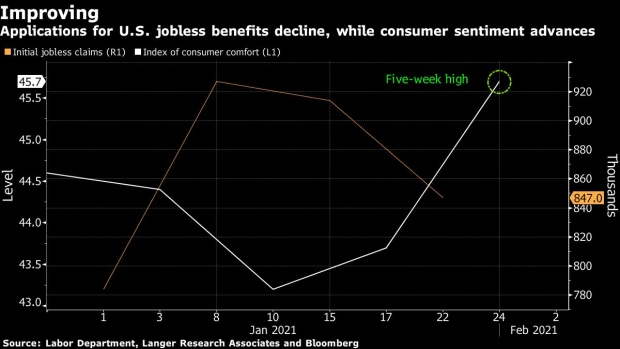Feb 3, 2021
U.S. Economy Is Improving, Complicating Biden’s Stimulus Plans
, Bloomberg News

(Bloomberg) -- The U.S. economy is showing some scattered signs of picking up from an end-of-year slowdown, muddying President Joe Biden’s efforts to win congressional passage of a $1.9 trillion stimulus package.
New claims filed for unemployment benefits have fallen for two straight weeks, while January payrolls are forecast to rebound from a December swoon in data out on Friday. Managers in charge of buying supplies for U.S. companies reported increased business last month and homebuilders said demand remained robust.
Selected high frequency data, such as weekly consumer confidence readings and restaurant bookings, also point to some strengthening, as virus infections ebb and business restrictions are eased.
“We’re seeing percolating growth underneath the surface,” said Gregory Daco, chief U.S. economist at Oxford Economics.
The tentative improvement comes as Biden’s mammoth package runs into opposition from some lawmakers who question whether that much support is needed on top of the more than $3 trillion the federal government has already delivered or committed.
Read More on Stimulus: Biden, Yellen Tell Democrats GOP Plan Too Small
Jobs Report
The next major update on the economy comes on Friday with the Labor Department’s release of monthly jobs numbers for January. Economists’ estimates for the change in non-farm payrolls vary widely -- from a decline of 250,000 to an increase of 400,000.
The median forecast in the Bloomberg survey calls for a 70,000 gain after December’s 140,000 drop. In November, employment increased 336,000.
Wrightson ICAP LLC chief economist Lou Crandall said the data could be skewed higher by seasonal factors that take account of normal January layoffs of retail workers hired for the end-year holidays -- a development that didn’t occur at the same pace because of the pandemic.
“To the extent that job creation looks stronger it could take out some of the urgency” for passage of a broad-based stimulus plan as opposed to a more targeted one, said Michelle Meyer, head of U.S. economics at Bank of America Corp.
She cautioned though that the near-term path of the economy will be determined by the country’s progress in getting the virus under control, especially now that new, more contagious variants have shown up in the U.S.
‘Inflection Point’
The economy looks to be already benefiting from the $900 billion aid package Congress approved in late December, with credit and debit card data compiled by Bank of America showing a pickup in consumer spending.
Jefferies LLC economists Aneta Markowska and Thomas Simons see February as an “inflection point” with growth picking up steam after slowing to an annualized rate of 4% in 2020’s fourth quarter from a record 33.4% pace in the third.
Read More: Bloomberg Economics Tracks Recovery in High-Frequency Dashboard
The Congressional Budget Office said Monday that it sees the nation’s gross domestic product recovering from the coronavirus pandemic much faster than previously expected -- even before any further stimulus from the federal government. It forecast that GDP will expand 4.6% this year -- the fastest pace since 1999 -- after contracting by 3.5% in 2020.
If Biden’s package is approved in its entirety, federal government assistance to the economy during the pandemic will clock in at around 25% of annual GDP of almost $21.5 trillion. That compares with the roughly 10% hole the virus tore into the economy at the height of its impact.
“Economists are saying there is room for additional support,” said Peter Hooper, global head of economic research for Deutsche Bank. “The argument is how much do you want to overshoot.”
Biden administration officials tout the advantages of going big. They point to the ravages caused by Covid-19 -- about 10 million fewer Americans are employed since the pandemic began a year ago -- and argue that now is not the time for the government to hold back.
“We have a real urgency to act and to act comprehensively,” Brian Deese, director of the White House’s National Economic Council, said in a Jan. 31 interview on NBC’s “Meet the Press” news show. “A piecemeal approach, where we try to tackle one element of this and wait and see on the rest, is not a recipe for success.”
Proponents of the package also maintain that it will help limit long-term damage to the economy by returning GDP and the jobs market back to their pre-pandemic heights more quickly.
In making the case for a smaller plan, former CBO Director Douglas Holtz-Eakin said that what’s holding back the economy is the virus, not a lack of money in consumers’ pockets. The personal saving rate stood at 13.7% in December, more than double its average since 2000.
“If we get another jump in the savings rate what are they going to do with it?” asked Holtz-Eakin, who’s now president of the American Action Forum and served as an adviser to the late Republican Senator John McCain. “Are they going to go out and buy GameStop?”
After skyrocketing on heavy retail purchases and short-covering by hedge funds, shares of video-game retailer GameStop Corp. plunged on Tuesday as the buying evaporated.
Most Wall Street economists are betting that Biden will get some, but not all, of the extra spending he’s seeking. But that will still be enough to substantially lift GDP in the coming quarters.
“The economy will be fueled by a one-two punch of virus containment and stimulus support,” Meyer said. She sees GDP rising at a 7.5% clip in the second quarter and 10% in the third on the back of another $1 trillion in stimulus.
©2021 Bloomberg L.P.





